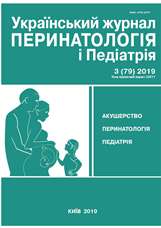To the question of the differential diagnosis of fever of unknown origin in children: a special case
DOI:
https://doi.org/10.15574/PP.2019.79.49Keywords:
children, fever, inflammatory bowel diseasesAbstract
Fever is the most common complaint when examining pediatric patients, most often due to viral or bacterial infections. However, in some clinical situations, determining the cause of a fever is significantly difficult and may require a very wide range of differential diagnostics, which includes numerous laboratory tests and various specific methods of visualizing various structures of the child's body. In rare cases, persistent fever remains a fever of unknown origin for a long time. Fever of unknown origin is understood as a pathological condition, the main manifestation of which is fever above 38.3°C with multiple rises in body temperature for 3 weeks or more, the etiology of which has not been established, despite a set of diagnostic studies. Fever of unknown origin is one of the most difficult clinical situations for health care workers, since there is not a single diagnostic gold standard, it still remains a challenge for every doctor and requires a thorough approach to each specific case. The main directions of the diagnostic search in a child with a prolonged rise in body temperature are the exclusion of three groups of diseases: autoimmune, oncological and infectious. A clinical case with the debut of the disease from fever of unknown origin in a child is presented, a feature of this case is the absence for a long time of a sufficient number of clinical diagnostic criteria for inflammatory bowel diseases, and the sequential process of differential diagnosis is considered.
The research was carried out in accordance with the principles of the Helsinki Declaration. The study protocol was approved by the Local Ethics Committee (LEC) of all participating institution. The informed consent of the patient was obtained for conducting the studies.
No conflict of interest were declared by the authors.
References
Dzyak V, Vasilenko AM, Potabashniy VA i dr. (2015). Lihoradka neyasnogo geneza. Printsipyi diagnosticheskogo poiska. Zdorov'ia Ukrainy. 2, 3. URL: http://health-ua.com/multimedia/userfiles/files/2015/ZU_4_2015/ZU_04_2015_st22-24.pdf.
MOZ Ukrainy. (2007). Klinichnyi protokol nadannia medychnoi dopomohy khvorym z hariachkoiu nevidomoho henezu, zatverdzhenyi nakazom MOZ Ukrainy No. 626 vid 08.10.2007. URL: https://zakon.rada.gov.ua/rada/show/v0626282-07.
MOZ Ukrainy. (2016). Unifikovanyi klinichnyi protokol pervynnoi, vtorynnoi (spetsializovanoi) ta tretynnoi (vysokospetsializovanoi) medychnoi dopomohy. Zapalni zakhvoriuvannia kyshechnyka (khvoroba krona, vyrazkovyi kolit): zatverdzheno nakazom MOZ Ukrainy No. 90 vid 11.02.2016 r.
http://mtd.dec.gov.ua/images/dodatki/2016_90_Krona/2016_90_YKPMD_Kron.pdf.
Ostrovskyi MM, Stovban MP. (2013). Otsinka stanu problemy hariachky neiasnoho genezu u klinichnii praktytsi. Halytskyi likarskyi visnyk. 20, 2: 158–164. URL: http://nbuv.gov.ua/UJRN/glv_2013_20_2_56.
Shapak IP, Bondar MV, Kharchenko LA, Tsvyk IM ta in. (2015). Diahnostyka prychyn lykhomanok nevidomoho genezu. Meditsina neotlozhnyih sostoyaniy. 3: 20–25. URL: http://nbuv.gov.ua/UJRN/Medns_2015_3_5.
Chow A, Robinson J. (2011). Fever of unknown origin in children: a systematic review. World. J. Pediatr. 7 (1), February 15. URL: https://www.researchgate.net/publication/49715025_Fever_of_unknown_origin_in_children_A_systematic_review. https://doi.org/10.1007/s12519-011-0240-5; PMid:21191771
Consensus guidelines of ECCO/ESPGHAN on the medical management of pediatric Crohn's disease. (2014). Journal of Сrohn's Сolitis. 8: 1179–1207. URL: http://www.spgp.pt/media/1068/pdf7.pdf.
Horowitz H, Horowitz M. (2013). Fever of unknown origin or fever of too many origins? The new england journal of medicine. January 17: 197–199. URL: http://unmhospitalist.pbworks.com/w/file/fetch/62862208/NEJMp1212725.pdf. https://doi.org/10.1056/NEJMp1212725; PMid:23323894
James W. Antoon, Nicholas M. Potisek, Jacob A. Lohr. (2015). 6 Pediatric Fever of Unknown Origin. Pediatrics in Review. 36 (9). URL: https://pedsinreview.aappublications.org/content/36/9/380?sso=1&sso_redirect_count=5&nfstatus=401&nftoken=00000000-0000-0000-0000-000000000000&nfstatusdescription=ERROR%3A%20No%20local%20token&nfstatus=401&nftoken=00000000-0000-0000-0000-000000000000&nfstatusdescription=ERROR%3a+No+local+token.
Levine A, Koletzko S, Turner D. (2014). ESPGHAN Revised Porto Criteria for the Diagnosis of Inflammatory Bowel Disease in Children and Adolescents. Society guideline. 58 (6). URL: http://www.espghan.org/fileadmin/user_upload/guidelines_pdf/2014_Revised_PORTO_criteria__JPGN_.pdf.
Mamula P. (2017). Pediatric Inflammatory Bowel Disease. Springtr: 754. URL: https://books.google.com.ua/books?id=Au8mDwAAQBAJ&printsec= frontcover&hl=uk&source=gbs_ge_summary_r&cad=0#v=onepage&q&f=false. https://doi.org/10.1007/978-3-319-49215-5
Unger M, Karanikas G, Kerschbaumer A et al. (2016). Fever of unknown origin (FUO) revised. Wien Klin Wochenschr. Sep. 26. URL: https://www.researchgate.net/publication/308669585_Fever_of_unknown_origin_FUO_revised. https://doi.org/10.1007/s00508-016-1083-9; PMid:27670857 PMCid:PMC5104815
Downloads
Issue
Section
License
The policy of the Journal “Ukrainian Journal of Perinatology and Pediatrics” is compatible with the vast majority of funders' of open access and self-archiving policies. The journal provides immediate open access route being convinced that everyone – not only scientists - can benefit from research results, and publishes articles exclusively under open access distribution, with a Creative Commons Attribution-Noncommercial 4.0 international license(СС BY-NC).
Authors transfer the copyright to the Journal “MODERN PEDIATRICS. UKRAINE” when the manuscript is accepted for publication. Authors declare that this manuscript has not been published nor is under simultaneous consideration for publication elsewhere. After publication, the articles become freely available on-line to the public.
Readers have the right to use, distribute, and reproduce articles in any medium, provided the articles and the journal are properly cited.
The use of published materials for commercial purposes is strongly prohibited.

